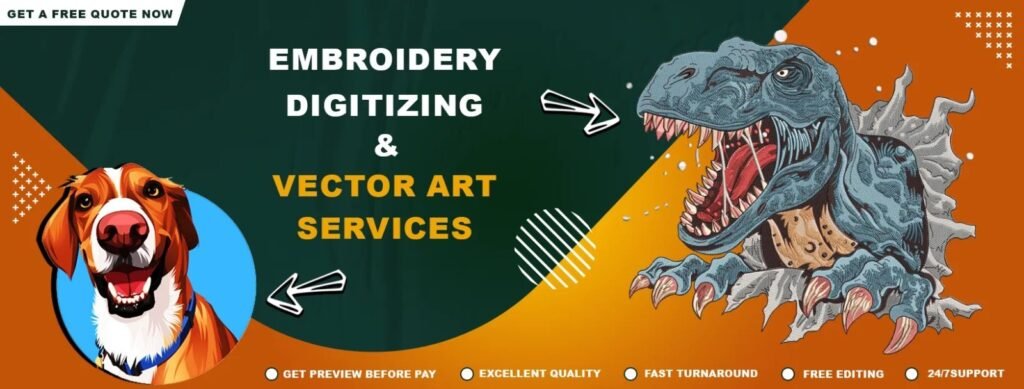Introduction
Custom embroidery digitizing is the process of converting digital artwork (like JPG, PNG, or AI files) into machine-readable embroidery files. One of the most popular formats is the PES file, used by Brother embroidery machines. Whether you’re a business creating branded apparel or a hobbyist making personalized gifts, understanding how to convert JPG to PES is essential for high-quality embroidery.
In this guide, we’ll cover:
✔ What custom embroidery digitizing is and why it matters
✔ How to convert a JPG to PES format
✔ Benefits of professional digitizing vs. DIY methods
✔ Choosing the best online digitizing service
✔ Tips for optimizing designs before digitizing
What Is Custom Embroidery Digitizing?
Embroidery digitizing is the art of translating an image into a stitch file that an embroidery machine can follow. Unlike printing, embroidery requires precise instructions for:
-
Stitch types (satin, fill, running stitches)
-
Thread colors & changes
-
Stitch direction & density
-
Underlay stitches (for fabric stability)
A well-digitized file ensures:
✅ Clean, professional embroidery (no gaps or misalignment)
✅ Minimal thread breaks (smooth stitching)
✅ Fabric-friendly results (no puckering or distortion)
Common Uses of Digitized Embroidery:
-
Custom apparel (hats, shirts, jackets)
-
Corporate branding (logos on uniforms)
-
Personalized gifts (towels, bags, quilts)
-
Promotional items (patches, badges)
How to Convert JPG to PES (Step-by-Step Guide)
The PES file format is used by Brother embroidery machines. Converting a JPG to PES requires digitizing software or a professional service.
Step 1: Choose the Right JPG Image
Not all images digitize well. The best designs have:
✔ Clear, bold outlines (avoid blurry or overly detailed images)
✔ Limited colors (gradients don’t translate well in embroidery)
✔ High contrast (ensures clean stitch separation)
Best for digitizing: Logos, text, simple illustrations.
Worst for digitizing: Photos, watercolor art, fine details.
Step 2: Clean Up the Image (If Needed)
Use graphic software (Adobe Illustrator, Photoshop, or free tools like GIMP) to:
-
Remove background noise
-
Simplify complex details
-
Convert to vector (for sharper edges)
Step 3: Digitize Using Embroidery Software
If doing it yourself, you’ll need digitizing software like:
-
Wilcom EmbroideryStudio (industry standard)
-
Hatch Embroidery (user-friendly)
-
Brother PE-Design (for home embroiderers)
-
Ink/Stitch (free open-source option)
Key steps in digitizing:
-
Trace the design (manually or auto-trace)
-
Assign stitch types (satin for borders, fill for large areas)
-
Set underlay stitches (prevents fabric shifting)
-
Adjust density & pull compensation (avoids puckering)
-
Test stitch on scrap fabric (check for errors)
Step 4: Save as PES & Export
Once perfected, export the file in .PES format for Brother machines (or other formats like .DST for Tajima).
Why Use Professional Digitizing Services?
While DIY digitizing is possible, professional services offer major advantages:
Benefits of Professional Digitizing:
✅ Perfect stitch quality (experts optimize every detail)
✅ Faster turnaround (24-48 hours vs. days of trial-and-error)
✅ No software costs (saves $100s on programs like Wilcom)
✅ Revisions included (fixes if the first test has issues)
Best Online JPG-to-PES Digitizing Services:
| Service | Best For | Price Range |
|---|---|---|
| DigitEMB | Fast, affordable digitizing | $10-$30 |
| Embird Online | High-end, detailed work | $20-$60 |
| iDigitizing | Bulk orders & businesses | $15-$50 |
| Fiverr/Upwork | Custom freelance digitizers | Varies |
DIY vs. Professional Digitizing: Which Should You Choose?
Option 1: DIY Digitizing (Using Auto-Digitizing Software)
✔ Pros:
-
Lower cost per design
-
Full creative control
✔ Cons: -
Steep learning curve
-
Often lacks professional polish
Best for: Hobbyists willing to practice.
Option 2: Professional Online Digitizing
✔ Pros:
-
Flawless, production-ready files
-
No software investment
-
Faster results
✔ Cons: -
Cost adds up for frequent use
Best for: Businesses & those needing perfect embroidery fast.
How to Choose the Best Digitizing Service
1. Check Reviews & Portfolio
Look for Google, Trustpilot, or Etsy reviews. Ask for sample files.
2. Compare Pricing
-
Simple logos: $10-$20
-
Complex designs: $30-$60+
Avoid ultra-cheap services—quality often suffers.
3. Turnaround Time
Need it fast? Look for 24-hour rush options.
4. File Formats Offered
Ensure they provide PES (or other formats like .DST, .EXP if needed).
5. Revisions Policy
A good service offers 1-2 free fixes if the first file has issues.
Tips for Optimizing JPGs Before Digitizing
To get the best PES file:
✔ Use high-resolution images (300+ DPI)
✔ Simplify complex designs (remove tiny details)
✔ Increase contrast (helps stitch separation)
✔ Avoid gradients (use solid colors instead)
Future of Embroidery Digitizing
1. AI-Powered Digitizing
New tools (like SewArt) auto-digitize, but human refinement is still needed.
2. Instant Online Quotes
Some services now provide real-time pricing upon upload.
3. Mobile Digitizing Apps
Apps like Embrilliance let users preview designs on smartphones.
4. Cloud-Based Collaboration
Designers & digitizers work together online for faster edits.
Conclusion
Converting JPG to PES through custom embroidery digitizing ensures professional, stitch-perfect results. While DIY software exists, online digitizing services offer the best mix of speed, quality, and affordability.
Key Takeaways:
✔ PES files are for Brother machines—JPGs won’t work alone.
✔ Professional digitizing saves time & guarantees quality.
✔ Always test-stitch before full production.
✔ Choose a reputable service with good reviews.
Ready to Digitize Your Design?
Find a trusted online digitizer today and transform your JPG into flawless embroidery!







